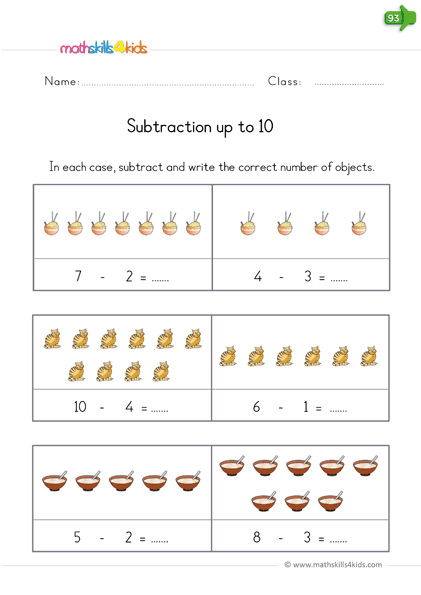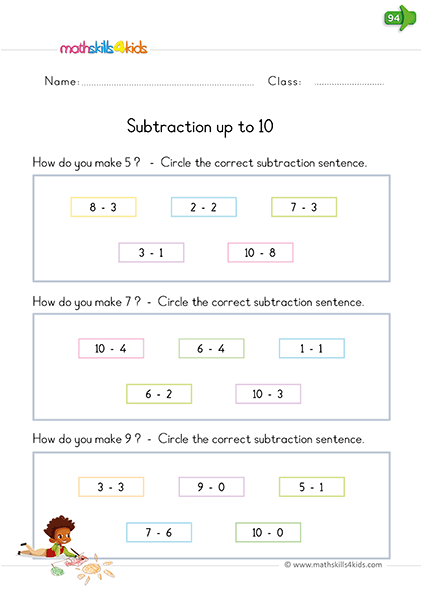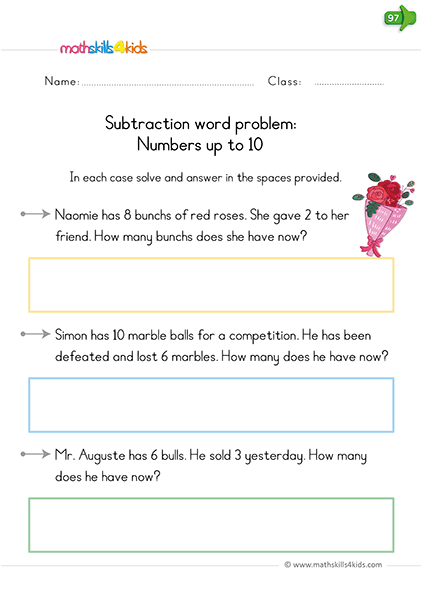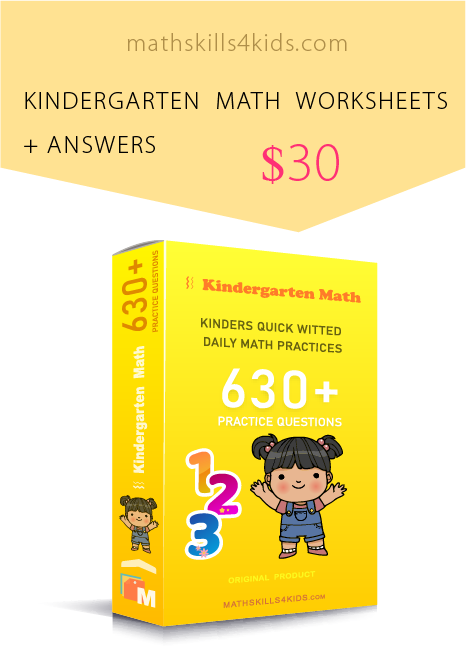Subtraction within 10 worksheets for kindergarten learners
Hello, math teachers and parents! Are you looking for some fun and engaging ways to help your kindergarten learners practice subtraction within 10? If so, you are in the right place!
In this article, we'll share with you some easy and effective subtraction within 10 worksheets that you can print and download for free.
-
These worksheets come with answer keys, so you can check your student's work and give them feedback. Plus, they are aligned with the Common Core Standards for kindergarten math, so you can be sure that your students are learning the essential skills they need.
By using attractive models and other fun subtraction strategies, your kids will enjoy learning all about taking away. This visual way of learning will keep your kids focused and enhance their self-confidence while subtracting.
Introduction: Why subtraction within 10 is important for kindergarten learners
Just like addition, subtraction within 10 is an important math concept that kindergarten learners need to develop before entering first Grade
It helps them understand the concept of taking away, essential for solving more complex math problems later on. It also helps them develop their number sense, which involves recognizing and working with numbers in different ways.
Moreover, subtraction within 10 reinforces other math skills, such as counting backward, comparing numbers, and finding missing addends. For example, if a student knows that 7 - 4 = 3, they can also use this fact to solve 4 + ? = 7 or 7 - ? = 4.
Above all, by mastering subtraction within 10, kindergarten learners will be more confident and prepared for higher-level math challenges in the future.
-
BROWSE THE WEBSITE
-
DOWNLOAD FREE WORKSHEETS
-
-
K- MATH TOPICS
- Learn to count up to 3
- Counting from 1 to 5
- Count up to 10
- Learn to count up to 20
- Counting to 100
- Skip counting
- Measurement
- Sum and difference
- Comparison
- Patterns
- Addition up to 5
- Addition up to 10
- Subtraction up to 5
- Subtraction up to 10
- 2D shapes
- Introduction to symmetry
- Position
- Fractions
- Time
- Classify
- Data and graph
- Probability
- 3D shapes
-
-
How to teach subtraction within 10 using concrete objects and manipulatives
One of the best ways to teach subtraction within 10 to kindergarten learners is to use concrete objects and manipulatives. These are physical items that students can touch, move, and manipulate to represent numbers and operations. For example, you can use blocks, counters, beads, buttons, or even candies to show subtraction within 10.
Using concrete objects and manipulatives helps students visualize and understand what subtraction means. It also helps them develop their fine motor skills and spatial awareness.
Here are some steps to follow when teaching subtraction within 10 using concrete objects and manipulatives:
- Start by introducing the subtraction symbol (-) and the word "minus" or "take away." Explain that subtraction means taking away some objects from a group of objects.
Give students a set of objects (for example, 10 blocks) and ask them to count them. Then ask them to take away some objects (for example, 3 blocks) and count how many are left.
Write down the subtraction equation on a board or a paper (for example, 10 - 3 = 7) and read it aloud with the students.
- Repeat this process with different numbers of objects and different amounts to take away. Make sure to use numbers within 10 only.
- Encourage students to use different strategies to solve subtraction problems, such as counting backward, using fingers, or using a number line.
- Check students' understanding by asking them questions such as "How many did you start with?", "How many did you take away?", "How many are left?" or "What is the answer?".
-
Fun and engaging subtraction within 10 activities and games for the classroom
Once students have learned how to subtract within 10 using concrete objects and manipulatives, you can reinforce their learning by using some fun and engaging subtraction within 10 activities and games for the classroom.
These activities and games will help students practice their subtraction skills in a playful and interactive way. They will also help them develop vital social skills, such as taking turns, sharing, and cooperating.
Here are some examples of subtraction within 10 activities and games for the classroom:
Subtraction Bingo: Create bingo cards with different subtraction equations within 10 on them. Give each student a bingo card and some markers (such as chips or stickers).
Call out random answers (such as 5 or 2) and have students mark off any equation on their card that matches the answer. The first student to mark off a row, a column, or diagonal wins.
Subtraction Memory: Create pairs of cards with matching subtraction equations and answers within 10 on them (such as 8 - 3 = 5 and 5 = 8 - 3).
Shuffle the cards and place them face down on a table. Have students take turns flipping over two cards at a time and trying to find a match.
If they find a match, they keep the cards and get another turn. If they don't find a match, they flip the cards back over and let another student have a turn.
The student with the most pairs at the end wins.
Subtraction Race: Divide students into two teams and give each team a set of objects (such as blocks or counters) and a dice.
Have each team line up at one end of the room. Have one student from each team roll the dice and subtract that number from 10. Then have them run to the other end of the room with that many objects in their hands.
Have them place their objects on a table or a tray at the other end of the room. Then have them run back to their team and tag the next student in line. The next student repeats the same process until all students have had a turn.
The team that finishes first wins.
-
Printable and downloadable subtraction within 10 worksheets with answer keys
You can count on our printable and downloadable subtraction within 10 worksheets with answer keys as your most reliable and effective resource that you can access at any time.
Apart from being one of the foundational skills that kindergarteners need to master, subtraction within 10 will also enhance their number sense, mental math, and problem-solving abilities within a twinkle of an eye.
It also prepares them for more advanced math topics, such as subtraction with larger numbers, regrouping, and fractions.
To help your students practice subtraction within 10, we have created three types of worksheets covering different aspects of this skill. You can use them as homework, classwork, or assessment tools.
Here they are:
- Subtracting with pictures: This type of worksheet helps your students visualize subtraction by using pictures of objects or animals. For example, they might see a picture of five apples and two apples crossed out and then write the subtraction sentence 5 - 2 = 3. This helps them understand what subtraction means and how to write it using symbols.
- Find the missing numbers in subtraction sentences: This type of worksheet challenges your students to find the missing number in a subtraction sentence. For example, they might see a subtraction sentence like 7 - ? = 4, and then write the missing number 3. This helps them build on their mental math skills and learn the inverse relationship between addition and subtraction.
- Solve real-life situations that involve subtraction from 10: This type of worksheet asks your students to apply their subtraction skills to real-world scenarios. For example, they might see a word problem like "Anna has 10 cookies. She gives 3 cookies to her friend. How many cookies does she have left?" and then write the subtraction sentence 10 - 3 = 7. This helps them connect math to their everyday lives and learn how to use subtraction to solve problems.
-
Tips and tricks for helping kindergarten learners master subtraction within 10
You will find in this resource very simple tips and tricks that will help kindergarten learners to master subtraction within 10 in less than no time.
This is because while worksheets are great for practicing subtraction within 10, they are not enough by themselves. You also need to use some effective teaching strategies to help your students master this skill.
Here are some tips and tricks that we have found useful:
- Use concrete manipulatives: Before introducing subtraction symbols, you should use concrete objects, such as counters, cubes, or fingers, to help your students understand what subtraction means. For example, you can show them how to take away some objects from a group and count how many are left. This will help them develop a strong sense of quantity and number relationships.
- Use songs, rhymes, and games: To make subtraction fun and memorable, you can use songs, rhymes, and games that involve subtraction within 10. For example, you can sing songs like "Five Little Monkeys" or "Ten in the Bed" that have subtraction lyrics. You can also play games like "Subtraction Bingo" or "Subtraction War" that require your students to subtract quickly and accurately.
- Use number lines: To help your students visualize subtraction as movement along a number line, you can use number lines as a tool. For example, you can show them how to start from a number and move backward by a certain amount to find the difference. You can also show them how to use a number line to check their answers by moving forwards by the same amount.
- Use word problems: To help your students apply their subtraction skills to real-life situations, you can use word problems that involve subtraction within 10. You can create your own word problems based on your students' interests and experiences, or use the ones from the worksheets we shared above. You can also teach your students how to use strategies like drawing pictures, acting out, or using manipulatives to solve word problems.
How to assess and reinforce subtraction within 10 skills
Our major objective in this resource is to reinforce subtraction within 10 skills to all kindergarteners.
To achieve this, therefore, you can encourage your little math learners to practice subtraction within 10 by using the worksheets we shared above, as well as some effective teaching strategies.
You can also assess your student's progress by using informal observations, quizzes, or tests. You can also reinforce their skills by providing them with feedback, praise, and encouragement.
By doing all these, you'll boost your kid's number sense skills, mental math, and problem-solving abilities. It also prepares them for more advanced math topics in the future.
Thank you for sharing the links of MathSkills4Kids.com with your loved ones. Your choice is greatly appreciated.
We hope you found this article helpful and informative. If you did, please share it with your fellow math teachers and parents who might benefit from it. Also, don't forget to download the free printable subtraction within 10 worksheets with answer keys from the link below.
Happy teaching!
Useful links
Subtract within 20 without borrowing worksheets | K5 Learning:
https://www.k5learning.com/free-preschool-kindergarten-worksheets/subtraction/subtract-within-20-no-borrowSubtraction within 5 and 10 | Planes & Balloons:
https://www.planesandballoons.com/2020/03/22/subtraction-within-10-kindergarten-worksheets/ -





